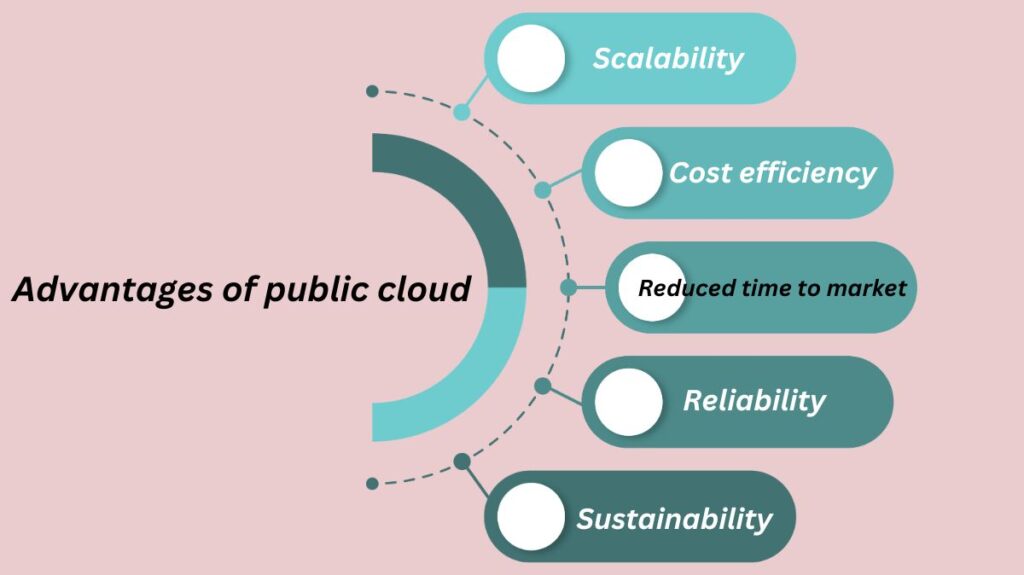Advantages of public cloud
Whatever your needs are, from basic web hosting to sophisticated machine learning applications, public cloud service providers can help. A public cloud offers advantages like these.

Scalability
There is almost infinite scalability available with public clouds. Running out of capacity is not a concern when you swiftly adjust resource utilisation to meet demand. From public cloud data centres across the globe, you can implement services closer to your end users. Even when scaled, this provides superior performance.
Economical effectiveness
The pay-as-you-go paradigm governs how public clouds function. By just paying for the resources you use, you avoid having to make large upfront investments in infrastructure and hardware. Considerable cost reductions may result from this. Variable pricing structures, such as the free tier and save when you commit, enable your company to further reduce expenses.
Reduced time to market
Patching, upgrading, and maintaining the infrastructure are the responsibilities of the cloud service provider. Your IT staff can then concentrate on value-added projects rather than standard maintenance duties. The development of solutions and experimentation might be given priority by your developers to better satisfy client needs. Without having to do the necessary research, purchase, and infrastructure setup, they can make use of the newest technologies.
Compared to previous approaches, prebuilt services and tools allow you to deploy new applications and services in a fraction of the time.
Reliability
Maintaining numerous data centres across the globe, your public cloud provider makes significant investments in infrastructure. You have access to the newest software and hardware since third-party sources make sure that all fixes and upgrades are current. In order to help guarantee data resilience, you can also utilise disaster recovery and automatic backup options. Using technologies like load balancers and content delivery networks in conjunction with automatic redundancy results in excellent availability and reliability.
Maintaining Sustainability
In order to maximize energy efficiency, public cloud service providers use economies of scale and have the financial resources to invest in renewable energy sources. In every facet of their cloud architecture, from hardware selection and data Centre design to performance modelling for ongoing enhancement, they can concentrate on energy saving. Making use of shared resources in a public cloud can help businesses lower their carbon impact. Your cloud service provider might also give you with resources and tools to track how your use of cloud services affects the environment and lessen your environmental impact.
Disadvantages of public cloud computing
Among the public cloud’s many drawbacks are:
Safety and confidentiality
Since public clouds are shared infrastructures, numerous users and companies can share the same network resources and hardware. The storage of sensitive data and applications alongside those of other users may raise security and privacy issues.
Control of costs
Big-scale consumption can result in an exponential increase in the total cost of ownership (TCO), particularly for moderate to big businesses.
Absence of technical oversight
Configuration and other IT management control are lost when you outsource to the public cloud.
Dependency on the vendor
It makes you reliant on the public cloud provider.
Absence of alternatives
Standard alternatives from public cloud providers typically take a one-size-fits-all approach, which could not satisfy the particular requirements of a business.
Dependency on the internet
To use cloud services, a continuous internet connection is necessary.
Unavailable time
Businesses that depend on the internet for cloud storage or data access may suffer from outages.
Conformity
Compared to on-premises hardware, public cloud compliance and regulations might be more challenging to manage.
Public Cloud companies
Third-party public cloud platforms supply computing resources online. Sharing servers, storage, apps, and services, these platforms offer on-demand access. These public cloud systems are popular today:
Amazon Web Services
AWS is the most popular public cloud platform, including computation, storage, databases, machine learning, IoT, and more.
Web hosting, analytics, app development, and enterprise IT infrastructure.
Microsoft Azure
Overview: Azure supports open-source frameworks and works nicely with Windows.
Enterprise, hybrid cloud, and AI/ML workloads.
Google Cloud Platform (GCP)
Overview: Google Cloud Platform provides innovative, data-driven cloud computing services.
Data processing, machine learning, and app modernisation.
IBM Cloud
Introduction: IBM Cloud offers public, private, and hybrid cloud services for enterprises, focusing on AI and blockchain.
Use Cases: Blockchain, AI, and secure enterprise cloud solutions.
Oracle Public Cloud
Oracle Cloud excels in database services and enterprise workloads, making it excellent for large companies.
ERP, database, and enterprise SaaS solutions.
Alibaba Cloud
Overview: Asia’s largest cloud provider, Alibaba Cloud, provides comprehensive business solutions.
Examples: E-commerce, IoT, and worldwide company expansion.
DigitalOcean
Developers and SMBs use DigitalOcean for its simplicity and affordability.
Web developers, startups, and small apps.
VMWare
VMware Cloud lets enterprises transfer and manage workloads across hybrid and multi-cloud systems.
Virtualization and hybrid cloud solutions for enterprises.

[…] Businesses frequently wish to use public clouds to update their IT infrastructure, but they may be prevented from completely closing a private data centre due to old applications or compliance issues. Businesses with a variety of data and application types can move some of their IT infrastructure to the cloud and keep some apps on-site with hybrid cloud computing. […]